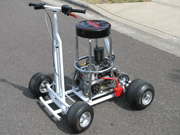
Bar Stool Racer

Bar stool racers are a relatively new and interesting take on the traditional go-kart. A stool of a type you would normally find your local watering hole, is mounted above a single cylinder engine on a go-kart type frame. Handlebars (usually) with throttle and brake levers provide steering and control.
Racing is generally held on small dirt/grass tracks or inside arenas with surfaces that enable a "softer" landing than asphalt. From a survey of events, most racing takes place in the USA or Canada. These machines are also considered for novelty purposes beyond racing (i.e. Parades, run-abouts at other racing events)
Bar Stool Racer Contents
| Power and Weight Stats | |
| Horsepower (Typical Range) | 8-12 |
| Race Weight (Typical Range) | 122-170 kg 270-375 lb |
Design and Construction
Race Car Models of This Type
There are numerous variations on the theme described above, including the use of steering wheels, pedals, and just for fun, wings.
Build Your Own Bar Stool Racer
Knowledge Level
If you are interested in building a new and better bar stool racer then scratch building will be the way to go. If you are interested in building an existing design then there are pre-fabricated bar stool racer frames and parts kits that only require assembly.
If you are scratch building a new design, you should be knowledgeable in handling, chassis, powertrain, and safety design as far as it relates to a non-suspension kart-type chassis. It is easy to underestimate the skill required to build a custom racing machine, and the "Suspensionless" kart chassis is no exception. A working knowledge of vehicle handling, tube chassis design, powertrain and safety considerations will leave you far more confident in your design than a trial-and-error approach.
Design Challenges
Weight Distribution: Due to the high center of gravity that results from having the driver sit on top of a stool, having a good static weight distribution is important. Consider how much acceleration or braking force you might experience and if possible, adjust the front/rear seating position to compensate. Doing so may permit "harder acceleration" and "harder braking" without flipping over.
For racing purposes, the lower the seating position the better, but depending on regulations there may be a minimum seat high to prevent your barstool racer from turning into a kart.
Suspension: Like a kart, the barstool racer has no suspension and instead relies upon flex in the chassis and upon front wheel geometry that causes the chassis to "tricycle" around corners by lifting the inside rear wheel. For maximum cornering ability, a wider track width is better.
Chassis: The chassis does not need to be absolutely rigid, and in fact benefits from some flex. Usually there is a need for basic cross-bracing to ensure the chassis/frame remains straight (i.e. When viewed from above). When viewed from the side, the frame will bend slightly when the wheels go over a bump.
Powertrain: Alignment of the engine and drive sprocket is important, as is the clearances around and accessibility of the brake caliper and master cylinder. When designing, consider changing brake fluid, bleeding accessibility. If racing on dirt, you may wish to consider bearings with dust shields.
Safety: Consideration should be given to securing critical fasteners with castellated nuts and safety wire to prevent failures of brakes, loss of wheels, or drivetrain components.
If you intend to race under a sanctioning body, always read and understand the regulations of your chosen racing class before designing or building any race vehicle.
Design Resources
Learn the basics about race cars and race car design from our free online knowledge series
Download our free race car design aids to assist you designing your race vehicle.
In-depth books and learning resources we recommend for bar stool racer design.
Join our forum to ask and find answers to your bar stool racer design/construction questions.
Construction Challenges
To ensure the correct front wheel geometry, use a jig to hold pieces at the correct angles for welding or brazing. Use of a solid, flat and level build space is also important.
Having sufficient space for the build is important, as a cramped workshop can be difficult to work in.
The tools to fabricate the chassis (ie. welder, metal working) can add considerably to the cost of your project if you don't already have a workshop, but borrowing or renting items is also an option.
Build Costs
All components are available off-the-shelf as typical go-kart items, so the cost is generally the lowest of any type of racing machine.
Build Effort
If the bar stool racer is scratch-built, there will be significant effort in design and construction, but far less than a race vehicle with suspension or complex chassis and powertrain. If building from a pre-fabricated kit, the effort will be far less and focused on assembly.
Racing Cost
Very, very low. Tire replacement, except in the case of damage is infrequent.
Transportation and Support Equipment
Can be loaded into the back of a pickup truck or onto a small trailer. Support equipment can be carried in the transport vehicle.
1

